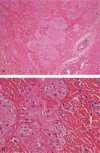A CARE-compliant article: Extranasal glial heterotopia in a female infant: A case report
- PMID: 30235657
- PMCID: PMC6160084
- DOI: 10.1097/MD.0000000000012000
A CARE-compliant article: Extranasal glial heterotopia in a female infant: A case report
Abstract
Rationale: Nasal glial heterotopia is a rare type of neoplasm consisting of meningothelial and/or neuroglial elements.
Patient concerns: A 17-month-old female infant was evaluated for treatment for a congenital mass present since birth on the right side of the nasal dorsum.
Diagnoses: The patient was preoperatively diagnosed with a congenital extranasal neoplasm.
Interventions: Surgery was performed under general anesthesia, and the mass was completely resected. The tissue was sent for histological examination, and the diagnosis was of extranasal glial heterotopia.
Outcomes: The surgical outcome was good, and no surgical site infection was recorded. After 6 months of follow-up, the girl was asymptomatic with no recurrence.
Lessons: Surgical excision, a curative method used to address extranasal glial heterotopia, resulted in no recurrence during the clinical follow-up period. The potential for an intracranial connection must always be kept in mind when considering how to surgically treat a congenital midline mass to prevent the risk of cerebrospinal fluid leakage.
Conflict of interest statement
The authors have no conflicts of interest to disclose.
Figures





Similar articles
-
Intranasal glial heterotopia in an infant boy.Pediatr Investig. 2021 Mar 22;5(1):69-72. doi: 10.1002/ped4.12222. eCollection 2021 Mar. Pediatr Investig. 2021. PMID: 33778431 Free PMC article.
-
Pediatric subcutaneous nasal glial heterotopia.Surg Neurol Int. 2025 Jan 3;16:1. doi: 10.25259/SNI_93_2024. eCollection 2025. Surg Neurol Int. 2025. PMID: 39926455 Free PMC article.
-
Intranasal glial heterotopia in a male infant: A case report.Medicine (Baltimore). 2020 Jul 17;99(29):e21200. doi: 10.1097/MD.0000000000021200. Medicine (Baltimore). 2020. PMID: 32702883 Free PMC article.
-
Nasal glial heterotopia: a clinicopathologic and immunophenotypic analysis of 10 cases with a review of the literature.Ann Diagn Pathol. 2003 Dec;7(6):354-9. doi: 10.1016/j.anndiagpath.2003.09.010. Ann Diagn Pathol. 2003. PMID: 15018118 Review.
-
Extranasal glial heterotopia: case report.Neurol India. 2003 Jun;51(2):248-9. Neurol India. 2003. PMID: 14571016 Review.
Cited by
-
A Rare Case of Nasal Glial Heterotopia in an Infant.J Cutan Aesthet Surg. 2020 Jul-Sep;13(3):233-236. doi: 10.4103/JCAS.JCAS_148_19. J Cutan Aesthet Surg. 2020. PMID: 33209002 Free PMC article.
-
A congenital extranasal glioma in a newborn.SAGE Open Med Case Rep. 2022 Dec 19;10:2050313X221144515. doi: 10.1177/2050313X221144515. eCollection 2022. SAGE Open Med Case Rep. 2022. PMID: 36569035 Free PMC article.
-
Intranasal glial heterotopia in an infant boy.Pediatr Investig. 2021 Mar 22;5(1):69-72. doi: 10.1002/ped4.12222. eCollection 2021 Mar. Pediatr Investig. 2021. PMID: 33778431 Free PMC article.
-
Pediatric subcutaneous nasal glial heterotopia.Surg Neurol Int. 2025 Jan 3;16:1. doi: 10.25259/SNI_93_2024. eCollection 2025. Surg Neurol Int. 2025. PMID: 39926455 Free PMC article.
References
-
- Rouev P, Dimov P, Shomov G. A case of nasal glioma in a new-born infant. Int J Pediatr Otorhinolaryngol 2001;58:91–4. - PubMed
-
- Hughes GB, Sharpino G, Hunt W, et al. Management of the congenital midline nasal mass: a review. Head Neck Surg 1980;2:222–33. - PubMed
-
- Bradley PJ, Singh SD. Congenital nasal masses: diagnosis and management. Clin Otolaryngol Allied Sci 1982;7:87–97. - PubMed
-
- Hedlund G. Congenital frontonasal masses: developmental anatomy, malformations, and MR imaging. Pediatr Radiol 2006;36:647–62. - PubMed
Publication types
MeSH terms
LinkOut - more resources
Full Text Sources
Other Literature Sources
Medical

